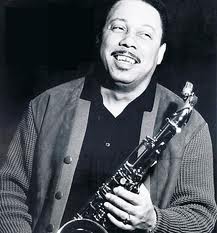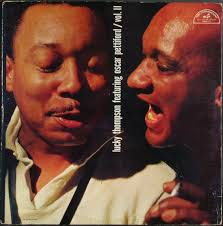Mister Man – Eli "Lucky" Thompson
A medium-up blues originally recorded on one of the classic Lucky Thompson/Oscar Pettiford trio sessions. Our own recording, from a quartet session featuring bassist Daryl Johns, has Minus You tracks for all instruments.
- Recording: Lucky Thompson - Featuring Oscar Pettiford, Vol. 2
- Recorded on: December 11, 1956
- Label: ABC-Paramount (ABC 171)
- Concert Key: F
- Vocal Range: , to
- Style: Swing (medium up)
- Tenor Sax - Lucky Thompson
- Bass - Oscar Pettiford
- Guitar - Skeeter Best
Video
- Description
- Historical Notes
- Solos
- Piano Corner
- Bass Corner
- Drum Corner
- Guitar Corner
- Inside & Beyond
- Minus You
Also like several other Lucky Thompson songs, this one has a striking rhythmic intro and coda with mostly quartal harmonies. After the first eight measures of the intro, there is a solo bass figure for four measures leading into the head.
Our Concert Condensed Score shows the guitar voicings and bass double-stops for this version's intro and coda. It also includes the guitar "answers" on the fourth and sixth measures of the head, which are different from the piano "answers" in our quartet version.
The basic lead sheets under each album are identical and are applicable for both recordings. The "Don Sickler Quartet" version album (above right) includes Minus You audio tracks.
Related Songs
Email Send Mister Man to a friend
- Recording: Don Sickler - Don Sickler Quartet featuring Daryl Johns
- Recorded on: January 31, 2010
- Label: jazzleadsheets.com (JLS 1001)
- Concert Key: F
- Vocal Range: , to
- Style: Swing (medium up)
- Trumpet - Don Sickler
- Piano - Michael Cochrane
- Bass - Daryl Johns
- Guitar - Steve Johns
Video
- Description
- Historical Notes
- Solos
- Piano Corner
- Bass Corner
- Drum Corner
- Guitar Corner
- Inside & Beyond
- Minus You
The Concert Condensed Score reflects these changes and should be used by piano and drums. The basic lead sheets are applicable for both recordings. The bass part shows the melody
This "session was recorded to feature bassist Daryl Johns, 13 years old at the time, on quartet versions of seven bass-centric songs. The others are Bet, Ease It, Visitation, The Plain But The Simple Truth, Dancing Sunbeam, and O.P. Meets L.T. (coming soon).
CLIP This is the format of the full track:
-- intro
-- melody [2 choruses]
-- trumpet solo [5 choruses]
-- piano solo [6 choruses]
-- trumpet and drums trading 4s [4 choruses]
-- bass solo [5 choruses]
-- out melody [2 choruses]
-- coda There are two different Minus Melody tracks, a practice edition with the same format and a shorter performance edition. In the practice edition, the soloist has the opportunity to play accompanied by bass and drums only, as well as by piano and drums only. For more information about these two minus melody editions, check out our "Gigi Gryce Project" songs with a similar format such as Salute to Birdland.
mp3 minus melody (this tracks works for any solo or melody instrument--get the lead sheet appropriate for your instrument)
-- count off sets up the intro
-- play the intro and melody
practice edition: solo [11 choruses]
5 choruses with full rhythm section
6 choruses with bass and drums
-- trade 4s with drums [4 choruses]
-- solo 5 more choruses with piano and drums
-- play the out melody and coda
performance edition: solo [5 choruses]
-- trade 4s with drums [4 choruses]
-- play the out melody and coda
mp3 minus Piano - there is a separate Piano part
-- count off sets up the intro
-- play figures and comp for the intro and melody
-- comp for the trumpet solo [5 choruses]
-- solo 6 choruses
-- comp for trumpet/drums trading 4s [4 choruses]
-- comp for the bass solo [5 choruses]
-- play figures and comp for the out melody and coda
mp3 minus Bass - the Bass part also works for the arrangement of the original recording
-- count off sets up the intro
-- play the intro and melody
-- walk for the trumpet solo [5 choruses] and piano solo [6 choruses]
-- walk for trumpet/drums trading 4s [4 choruses]
-- solo [5 choruses]
-- play the out melody and coda
mp3 minus Drums - Drummers should read from the Concert Condensed Score.
On this recording, drummer Steve Johns uses sticks for the intro, switching to brushes during the bass break. He plays brushes for the melody, switches to sticks at the beginning of the trumpet solo, to brushes for the bass solo and out melody, and back to sticks for the coda. Sticks or brushes throughout can also be explored, or any combination of changes between sticks and brushes.
-- count off sets up the intro
-- play figures and comp for the intro and melody
-- comp for the trumpet solo [5 choruses] and piano solo [6 choruses]
-- trade 4s with trumpet [4 choruses] (trumpet first)
-- comp for the bass solo [5 choruses]
-- play figures and comp for the out melody and coda
mp3 trio (minus melody: bass & drums only)
By eliminating the comping piano track from the minus melody track, we made a track where the pianist can play the melody and be featured throughout. This bass & drums only track also works great as a feature for guitar or any other instrument (tenor saxophonist Sonny Rollins loved to play with just bass and drums, for example). Perfect for an audition tape.
-- count off sets up the intro
-- play the intro and melody
-- solo 11 choruses
-- trade 4s with drums [4 choruses]
-- play the out melody and coda
Related Songs
Email Send Mister Man to a friend

Eli "Lucky" Thompson
June 16, 1923 – July 30, 2005
Saxophonist Lucky Thompson is one of the great treasures of jazz. He was born in Columbia, South Carolina, but was raised in Detroit, Michigan. He played in local groups with Hank Jones, Sonny Stitt and others. In August, 1943, when he was 19, he left Detroit with Lionel Hampton's Orchestra, eventually arriving in New York City. Still a teenager, his first recording date was with Hot Lips Page on March 18, 1944. Later in 1944 he started recording with both Lucky Millinder and Count Basie. Read more...


